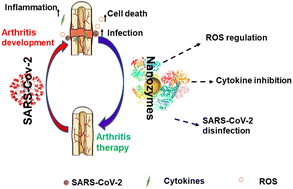Development of nanozymes for promising alleviation of COVID-19-associated arthritis
Abstract
The COVID-19 pandemic caused by SARS-CoV-2 has been identified as a culprit in the development of a variety of disorders, including arthritis. Although the emergence of arthritis following SARS-CoV-2 infection may not be immediately discernible, its underlying pathogenesis is likely to involve a complex interplay of infections, oxidative stress, immune responses, abnormal production of inflammatory factors, cellular destruction, etc. Fortunately, recent advancements in nanozymes with enzyme-like activities have shown potent antiviral effects and the ability to inhibit oxidative stress and cytokines and provide immunotherapeutic effects while also safeguarding diverse cell populations. These adaptable nanozymes have already exhibited efficacy in treating common types of arthritis, and their distinctive synergistic therapeutic effects offer great potential in the fight against arthritis associated with COVID-19. In this comprehensive review, we explore the potential of nanozymes in alleviating arthritis following SARS-CoV-2 infection by neutralizing the underlying factors associated with the disease. We also provide a detailed analysis of the common therapeutic pathways employed by these nanozymes and offer insights into how they can be further optimized to effectively address COVID-19-associated arthritis.

- This article is part of the themed collection: Coronavirus articles - free to access collection


 Please wait while we load your content...
Please wait while we load your content...